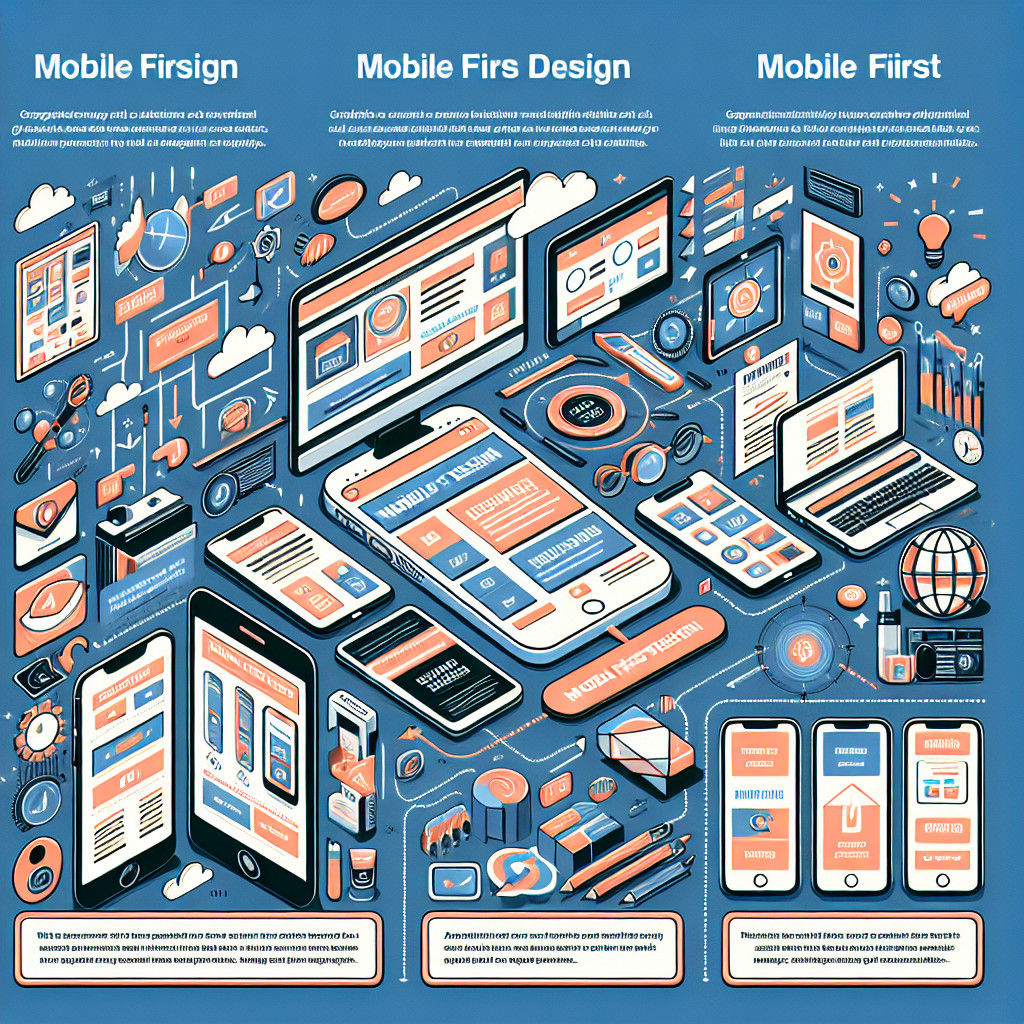Mobile First Design a performance (wydajność).

- Mobile First Design and performance optimization
- Mobile First Design for improved performance
- Mobile First Design enhancing performance
- Mobile First Design and performance metrics
- Mobile First Design with focus on performance
Mobile First Design and performance optimization
In today’s digital age, mobile devices have become the primary way people access the internet. With the increasing popularity of smartphones and tablets, it has become essential for websites to be optimized for mobile devices. This is where Mobile First Design comes into play.
Mobile First Design is a design strategy that prioritizes the mobile user experience over the desktop experience. This means that when designing a website, the focus is on creating a seamless and user-friendly experience for mobile users first, and then adapting it for larger screens.
One of the key benefits of Mobile First Design is improved performance. By designing for mobile first, websites are optimized for smaller screens and slower internet connections. This results in faster load times and a better overall user experience.
Here are some tips for implementing Mobile First Design and optimizing performance:
1. Responsive Design: Use responsive design techniques to ensure that your website looks and functions well on all devices, from smartphones to desktops. This includes using flexible grids and media queries to adapt the layout and content based on screen size.
2. Optimize Images: Images can significantly impact the performance of a website, especially on mobile devices. Use image optimization techniques such as compressing images, using the correct file format, and lazy loading to reduce load times.
3. Minify CSS and JavaScript: Minifying CSS and JavaScript files can help reduce the file size of your website, leading to faster load times. You can use tools like CSSNano and UglifyJS to minify your code.
4. Use a Content Delivery Network (CDN): A CDN can help improve the performance of your website by caching content on servers located closer to the user. This can reduce latency and improve load times, especially for users in different geographic locations.
5. Optimize Fonts: Use web-safe fonts and limit the number of font styles and weights to reduce the number of HTTP requests. You can also use font loading techniques like font-display: swap; to ensure that text is visible even if the font hasn’t fully loaded.
6. Avoid Flash and Heavy Animations: Flash and heavy animations can slow down your website, especially on mobile devices. Instead, use CSS animations and transitions for a smoother user experience.
7. Test Performance: Regularly test the performance of your website using tools like Google PageSpeed Insights and GTmetrix. These tools can help identify areas for improvement and optimize your website for better performance.
By implementing Mobile First Design and optimizing performance, you can create a website that provides a seamless and user-friendly experience for mobile users. Remember to prioritize performance optimization throughout the design process to ensure that your website loads quickly and efficiently on all devices.
Mobile First Design for improved performance
In today’s digital age, having a mobile-friendly website is no longer just a nice-to-have feature – it’s a necessity. With more and more people accessing the internet on their smartphones and tablets, it’s crucial for businesses to prioritize mobile design in order to provide a seamless user experience. One approach that has gained popularity in recent years is Mobile First Design.
Mobile First Design is a design strategy that prioritizes the mobile user experience over the desktop experience. By starting with the smallest screen size and working your way up to larger screens, you can ensure that your website is optimized for mobile devices first and foremost. This approach has several benefits, including improved performance, better user engagement, and higher conversion rates.
Here are some key reasons why Mobile First Design is essential for improved performance:
1. Improved loading times: Mobile devices typically have slower internet connections than desktop computers, so it’s important to optimize your website for speed. By designing with mobile in mind, you can reduce the size of images and other assets, minimize the number of HTTP requests, and prioritize content that is essential for mobile users. This can lead to faster loading times and a better overall user experience.
2. Responsive design: Mobile First Design encourages a responsive approach to web design, which means that your website will adapt to different screen sizes and resolutions. This ensures that your site looks great on any device, whether it’s a smartphone, tablet, or desktop computer. Responsive design can also help improve your site’s SEO, as Google now prioritizes mobile-friendly websites in its search results.
3. Improved user experience: By focusing on mobile users first, you can create a more intuitive and user-friendly experience for all visitors. This includes using larger fonts, clear navigation menus, and touch-friendly buttons that are easy to tap on a small screen. By making it easier for users to navigate your site on their mobile devices, you can increase engagement and keep visitors on your site longer.
4. Higher conversion rates: Studies have shown that mobile users are more likely to make a purchase or complete a desired action on a website that is optimized for mobile. By designing with mobile users in mind, you can create a seamless checkout process, easy-to-use forms, and clear calls to action that encourage users to take the next step. This can lead to higher conversion rates and increased revenue for your business.
In conclusion, Mobile First Design is a crucial strategy for improving the performance of your website. By prioritizing the mobile user experience, you can create a faster, more responsive, and more user-friendly website that will attract and retain visitors on any device. If you haven’t already adopted Mobile First Design, now is the time to make the switch and reap the benefits of a mobile-friendly website.
Mobile First Design enhancing performance
| Benefits of Mobile First Design |
|---|
| 1. Improved Performance: By designing for mobile first, designers are forced to prioritize content and features that are essential for the user. This results in a faster and more streamlined experience for mobile users. |
| 2. Better User Experience: Mobile First Design focuses on simplicity and usability, which can lead to a better overall user experience. By designing for mobile first, designers can create interfaces that are intuitive and easy to navigate on any device. |
| 3. Increased Conversion Rates: Mobile First Design can lead to higher conversion rates as mobile users are more likely to engage with a website that is optimized for their device. By prioritizing mobile design, businesses can attract and retain more customers. |
Overall, Mobile First Design is a design strategy that can greatly enhance performance and improve user experience. By prioritizing mobile design, businesses can create websites that are faster, more user-friendly, and ultimately more successful.
Mobile First Design and performance metrics
Benefits of Mobile First Design:
- Improved User Experience: Mobile first design ensures that websites and applications are easy to use on smaller screens, leading to a better user experience for mobile users.
- Faster Load Times: By optimizing for mobile devices, websites and applications can load faster on slower internet connections, reducing bounce rates and improving user engagement.
- Higher Conversion Rates: Mobile first design can lead to higher conversion rates as users are more likely to complete actions on a website that is optimized for mobile devices.
- SEO Benefits: Google prioritizes mobile-friendly websites in search results, so mobile first design can improve search engine rankings and drive more organic traffic to a website.
Performance Metrics to Consider:
- Page Load Time: The time it takes for a webpage to fully load on a user’s device. Faster load times lead to better user experiences and higher engagement.
- Time to First Byte: The time it takes for a server to respond to a user’s request. A fast time to first byte indicates a well-optimized server and network infrastructure.
- Render Time: The time it takes for a webpage to render and display content on a user’s screen. Faster render times lead to better user experiences and lower bounce rates.
- Conversion Rate: The percentage of users who complete a desired action on a website, such as making a purchase or signing up for a newsletter. Higher conversion rates indicate a well-designed and optimized website.
Best Practices for Mobile First Design:
- Responsive Design: Use responsive design techniques to ensure that websites and applications adapt to different screen sizes and devices.
- Optimize Images: Compress images and use lazy loading techniques to reduce load times and improve performance on mobile devices.
- Minimize HTTP Requests: Reduce the number of HTTP requests by combining files and using asynchronous loading techniques.
- Use a Content Delivery Network (CDN): Use a CDN to deliver content faster to users around the world and improve performance on mobile devices.
By following these best practices and focusing on mobile first design and performance metrics, developers can create websites and applications that provide a better user experience, faster load times, and higher conversion rates. Mobile first design is essential in today’s mobile-first world, where more users access the internet on mobile devices than on desktops. By prioritizing mobile design and performance, developers can create websites and applications that are optimized for the modern user and drive better results for businesses.
Mobile First Design with focus on performance
One of the key aspects of Mobile First Design is performance. Mobile users often have slower internet connections and less powerful devices compared to desktop users. Therefore, it is crucial to optimize websites for performance to ensure a smooth and fast user experience. This can be achieved through various techniques such as optimizing images, minifying code, and reducing server requests.
When designing a website with a focus on performance, it is important to consider the following factors:
1. Responsive Design: A responsive design ensures that the website adapts to different screen sizes and resolutions. This is essential for providing a consistent user experience across all devices.
2. Lightweight Design: Keeping the website lightweight by minimizing the use of large images, videos, and unnecessary code can significantly improve performance. This includes optimizing images for the web, using CSS sprites, and minifying CSS and JavaScript files.
3. Lazy Loading: Lazy loading is a technique that delays the loading of non-essential content until it is needed. This can help reduce the initial load time of the website and improve performance on mobile devices.
4. Caching: Caching is a process of storing static files such as images, CSS, and JavaScript on the user’s device to reduce server requests and improve loading times. Implementing caching mechanisms can greatly enhance the performance of a website.
5. Mobile Optimization: Designing for mobile devices requires a different approach compared to desktop design. This includes using larger fonts, touch-friendly buttons, and optimizing the layout for smaller screens. By focusing on mobile optimization, designers can create a seamless user experience for mobile users.
In conclusion, Mobile First Design with a focus on performance is essential for creating websites that cater to the needs of mobile users. By prioritizing mobile design and optimizing for performance, designers can ensure that their websites are fast, responsive, and user-friendly on all devices. Implementing techniques such as responsive design, lightweight design, lazy loading, caching, and mobile optimization can help improve the performance of a website and provide a better user experience for mobile users.
- Czy wynajem samochodu na miesiąc jest tańszy niż wynajem na krótszy okres? - 26 czerwca 2025
- Rehabilitacja kręgosłupa Tomaszów Mazowiecki - 25 czerwca 2025
- Pomocnik stolik w kuchni – pomocnik czy przeszkoda? - 17 czerwca 2025
